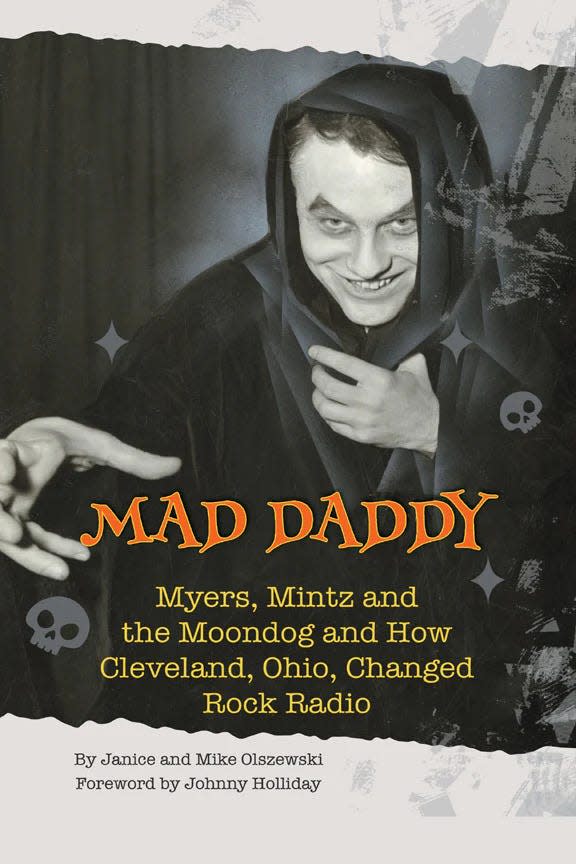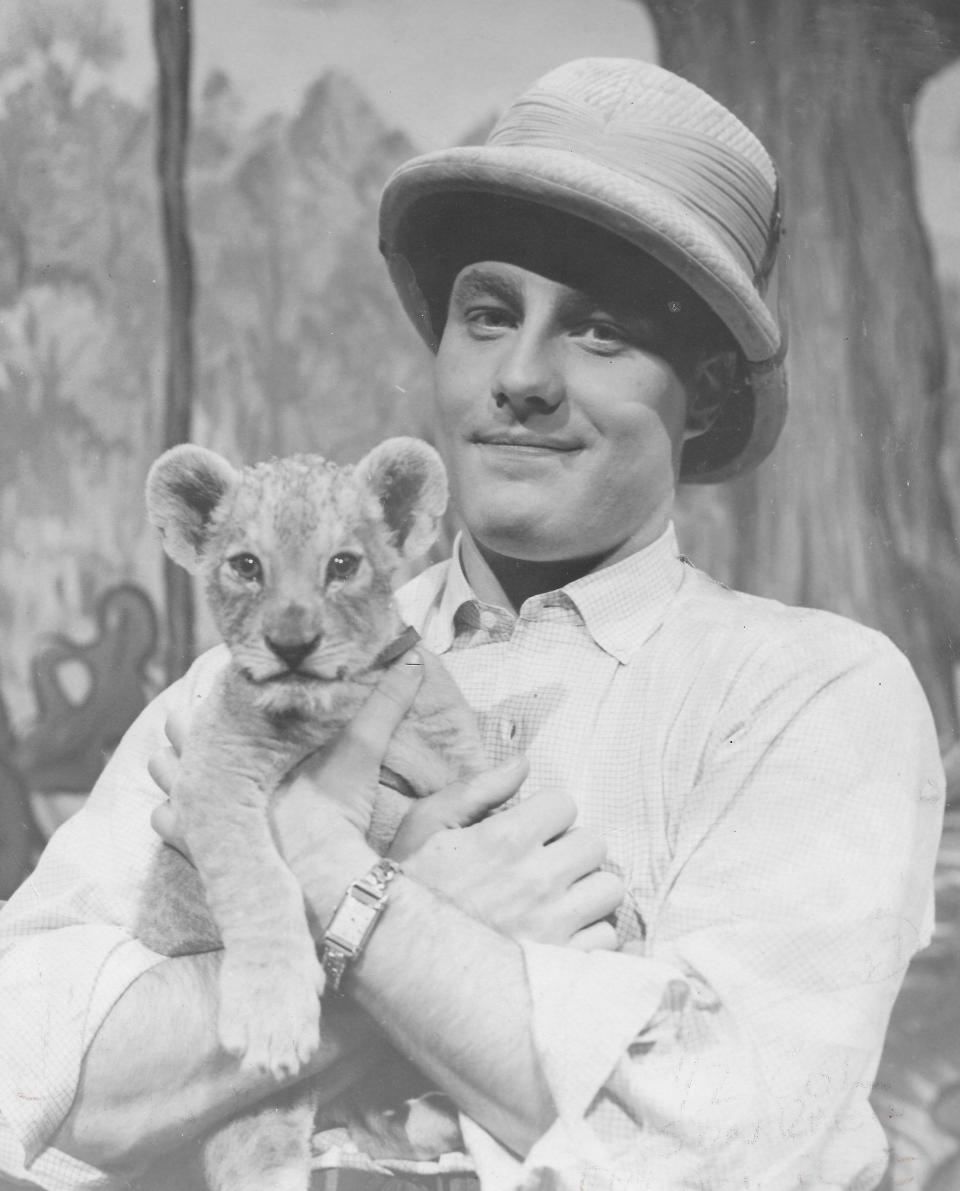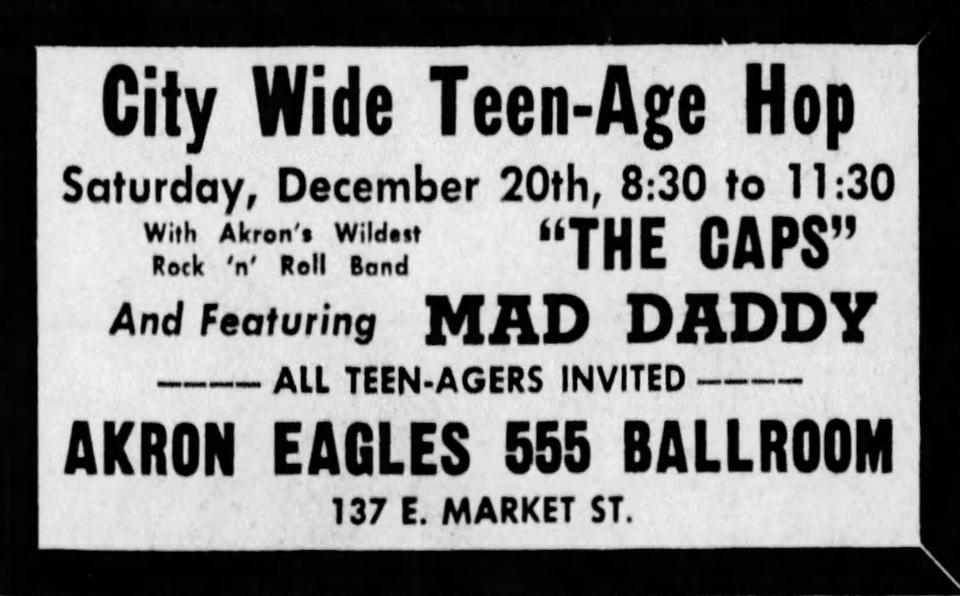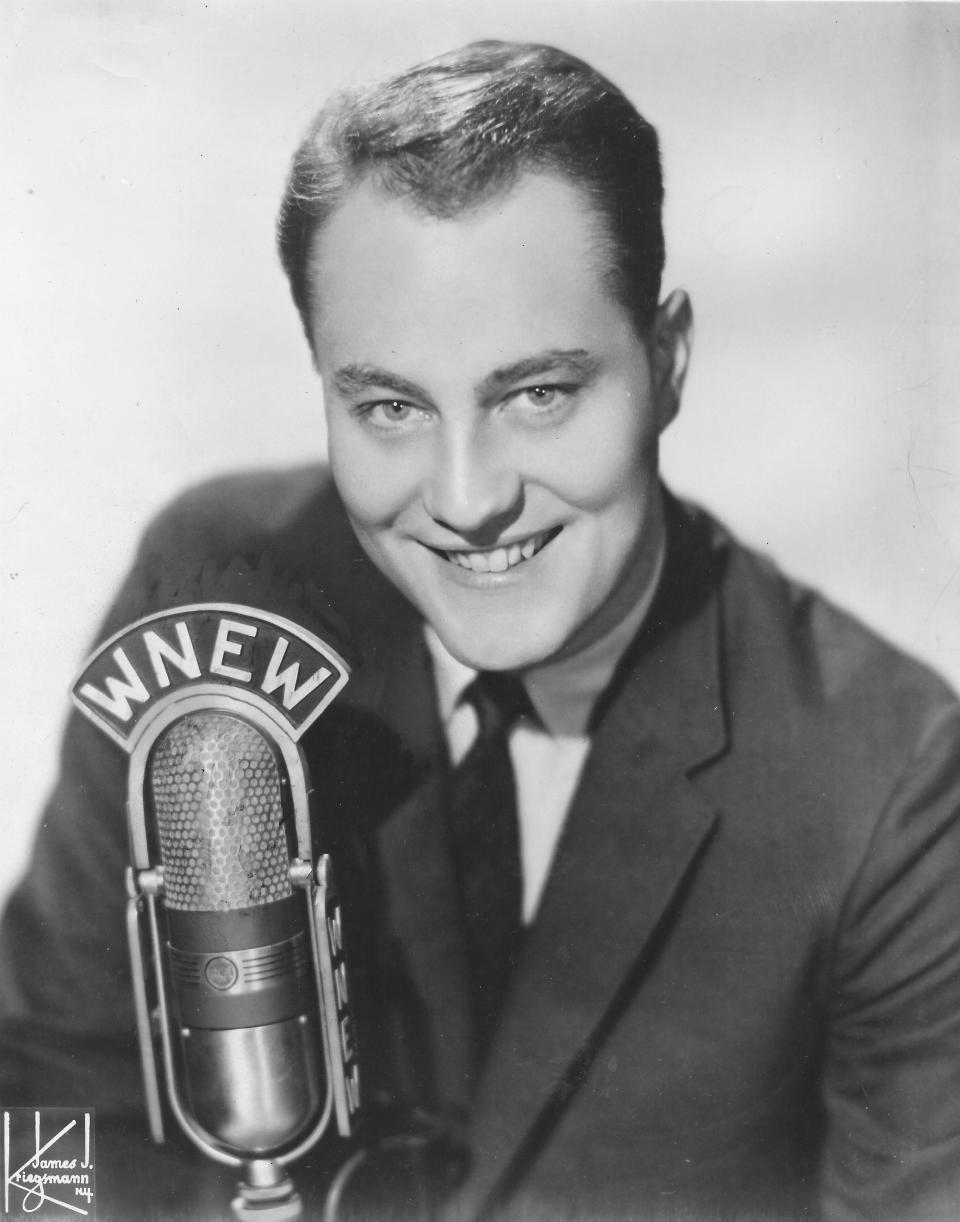Local history: ‘Mad Daddy’ Pete Myers went wild on Ohio radio

Disc jockey Pete Myers was a wild man of the airwaves in the 1950s.
By day, he was a lovable, laughable personality. When night fell, he became Mad Daddy, a fast-talking gothic beatnik who wore a cape, spoke in rhyme and championed rock ’n’ roll.
“There’s a thin line between genius and madness, and, boy, he was a good example,” said Mike Olszewski, co-author with his wife, Janice, of the new book “Mad Daddy: Myers, Mintz and the Moondog and How Cleveland, Ohio, Changed Rock Radio.”
Myers developed his mile-a-minute character on radio stations in Akron and Cleveland. He created his own lingo, popularizing catchphrases such as “Hang loose, Mother Goose,” “Wavy gravy” and “Mellow Jell-O.”
“Loopin’ and a scoopin’ and a rockin’ and a reelin’. This is Mad Daddy here and we’re hangin’ from the ceiling!” Myers babbled.
The disc jockey punctuated his rapid-fire banter with maniacal laughter and sound effects between records. Myers earned a rabid following among Ohio youths before moving to New York City.
“What an amazing guy,” Olszewski said.
The rise of Pete Myers
Pierre Ellis Myers, better known as Pete, was born April 7, 1928, in San Francisco. He attended high school in Los Angeles, graduated from the Royal Academy of Dramatic Arts in London and acted in theater.
Joining the Army in the late 1940s, Myers served at Camp Drake in Japan, where his mischievous streak bubbled to the surface. Myers got into hot water for performing a mock newscast on the Armed Forces Radio Network about a sea monster emerging from Tokyo Bay.
“This was before Godzilla, mind you,” Olszewski said.
Gen. Douglas MacArthur, who happened to be listening, was not amused. Myers got reassigned to a unit studying psychological warfare.

After the service, Myers landed a radio job at KCBQ-AM in San Diego, but soon left California for Ohio.
WHKK studio at O’Neil’s
In October 1956, Myers got hired at Akron’s WHKK (640 AM), hosting shows from 6 to 8:30 a.m. and 3:30 to 7 p.m.
He broadcast live from a downtown studio at O’Neil’s department store and played the latest songs from Elvis Presley, Buddy Holly, The Platters, Fats Domino and Little Richard. On weekends, he emceed teenage sock hops.
Olszewski’s interest in Myers began in 1985 as a reporter for WERE-AM in Cleveland when businessman Larry Collins played him an audiotape of Mad Daddy.
“I heard him and I thought, ‘Wow! This guy was amazing!’ ” he said. “I always kept it in the back of my head that I’d like to find out more about him.”
The book began in 2007 as Olszewski’s thesis for a master of arts degree at Kent State University. He interviewed people who knew Mad Daddy, including his brother Ernie Myers and former producer Neil McIntyre, both of whom have since passed away. For the book, he and Janice conducted more research and new interviews.
They even tracked down Mike Altimore and Travis Roudebush, Myers’ former roommates at Highland Square.
“When he was in Akron, he lived at 69 Beck Ave,” Olszewski said. “The house is still there. It was a boarding house at that time.”
Myers would return home late at night wearing a Dracula cape. He wasn’t much for personal conversation. Away from the microphone, he was pretty quiet.
“Everybody said the same thing: It was hard to know Pete Myers,” he said.
Monsters and beatniks
Myers developed Mad Daddy in Akron, although the character didn’t yet have a name. His humor was a combustible mixture of Mad Magazine, Famous Monsters of Filmland and beatnik culture.
“Pete Myers would come on the air for two hours as ‘lovable, laughable Pete Myers,’ ” Olszewski said. “Then he’d go home for dinner. When he came back, he was this crazy-talking beatnik named Mad Daddy.”

Myers came up with his own vernacular. Boys were “ghoul rockers,” girls were “mellow muffins” and fans were “oobladoodians.” In a process he called “zoomerating,” he made up nonsense words while reciting the alphabet, sometimes in reverse.
“He would come up with these rhymes off the top of his head 100 miles an hour,” Olszewski said.
After more than a year in Akron, Myers moved to Cleveland’s WJW (850 AM) in January 1958. The Mad Daddy character took off at full throttle, making a big impression in the larger market.
“There were two people there,” Olszewski said. “There was Pete Myers and there was Mad Daddy. They lived in the same body. When he came back to do the Mad Daddy, he told Pete Myers: ‘Go sit in the corner. I’m taking over.’ ”
Horror host on WJW-TV
In addition to radio shows, Myers briefly turned Mad Daddy into a horror movie host on WJW-TV (Channel 8), presenting a double feature at 11:20 p.m. Saturdays starting April 12. The show lasted about a month.
“He wanted them to hang one of those old TV cameras upside-down so it would look like he was upside-down,” Olszewski said. “They said, ‘Are you nuts? That’s 800 pounds.’
“So he hung upside-down and the blood would rush to his head. He said, ‘This TV is crazy. My audience is on radio.’ So he walked away from it.”
He left WJW in May for a job at Cleveland’s WHK, but he apparently forgot about the 90-day, no-compete clause in his contract. In an effort to maintain his visibility during the time off, he performed a high-profile stunt.
Myers dressed like Zorro and parachuted 2,200 feet from a Piper Cub into Lake Erie on June 14 as a TV promotion for the ABC series starring Guy Williams.
A Coast Guard official had estimated Myers’ chances of survival at 50-50.
“That’s better than I get at Hialeah racetrack,” Myers joked as he emerged from the cold water.
Mad Daddy became a superstar at WHK. Crowds came to the station every day to catch a glimpse of the caped character or seek his autograph.
His newsman was Ernie Anderson, who reigned a few years later on WJW-TV’s “Shock Theater” as the horror host Ghoulardi.
Mad Daddy and The Cramps
Erick Lee Purkhiser, who grew up to be horror-punk legend Lux Interior, the lead singer and co-founder of The Cramps, was among Myers’ legions of young fans.
“When he was living in Stow, Purkhiser used to call Mad Daddy at night,” Olszewski said. “Once he stayed on the phone so long, Mad Daddy said, ‘Wait a minute. Where do you live?’ ”
After Myers found out it was a long-distance call from Stow, he put the station’s secretary on the line.
“Daddy wants to pay for your call,” she told Purkhiser.
On their debut album in 1980, The Cramps released a song called “The Mad Daddy” as a tribute to the Cleveland disc jockey. Mad Daddy and Ghoulardi had a big influence on Ohio musicians, particularly punk bands who learned that anarchy could be entertaining, Olszewski said.
At WHK, Myers recorded the novelty tunes “What Is a Fisteris?” and “I Love a Practical Joke” under the pseudonym The Joker on the Cleveland label G & F Records.
Mad Daddy’s bizarre wordplay continued with such lyrics as: “A fisteris is as big as a grendel, tiny as a suzman and sometimes middle sized like a fremesis on nibbling on the freeze.”
The record contains a backward message that Olszewski reversed with modern technology. The secret message blurts: “If I said this in English, I could turn this radio station into a parking lot.’ ”
“It’s pretty weird,” Olszewski said.
From Cleveland to New York
Myers broke Ohio fans’ hearts when he left Cleveland for WHK’s sister station WNEW in New York. He had finally reached the largest market, but there was a catch: WNEW wasn’t a rock station. It played the music of Frank Sinatra and Tony Bennett.
Undaunted, Myers debuted his caped character July 4, 1959, on the East Coast. Station managers were not pleased.
“He did Mad Daddy one night,” Olszewski said. “And they said, ‘We didn’t hire this Mad Daddy. We hired lovable, laughable Pete Myers.’ He was crushed by that. Mad Daddy could not get a foothold there in New York.”

Myers played it straight at WNEW until New York’s top-rated station WINS recruited him in 1963. Mad Daddy returned to rock radio, but for whatever reason, the character never caught on like it had in Cleveland. WNEW hired him back in 1965.
Final ovation in Ohio
Myers didn’t realize how beloved he was in Ohio until he attended a rock revival show May 5, 1968, at Cleveland Arena. The concert, which featured Chuck Berry and Fats Domino, had 1950s disc jockeys as emcees.
“When Pete came back to Cleveland in 1968, he didn’t think anybody would remember him,” Olszewski said. “In fact, he told the promoter: ‘Don’t even get me a room. Just take me back to the airport after my appearance.’ ”
But when Mad Daddy stepped onstage, the crowd went berserk. Cheers, applause, laughter. One last time, Pete Myers conquered Cleveland.
Five months later, he was dead. After WNEW announced it was moving Myers from afternoon to late night, he died by suicide Oct. 4, 1968, in his Manhattan apartment. He was 40 years old.
The shift change made Myers realize that everything he had ever wanted he had left behind in Cleveland, his brother Ernie told Olszewski.
It was a tragic end for someone who had brought joy to so many.
“He was so huge,” Olszewski said. “He was so different.”
Do you have tapes?
Existing tapes of Mad Daddy are scarce. If anyone has recordings or memories of Pete Myers, email the authors at jannmike1978@gmail.com
Who knows? Maybe there will be a sequel for all the ghoul rockers, mellow muffins and oobladoodians.
“When we were writing this book, we didn’t want Mad Daddy to be forgotten,” Olszewski said. “Right now, he’s like a footnote in history. We wanted to make sure the history was told.”
Mark J. Price can be reached at mprice@thebeaconjournal.com
Details
Event: “Mad Daddy: A Celebration of How Cleveland Changed Rock Radio”
When: Noon to 4 p.m. July 27
Where: Music Box Supper Club, 1148 Main Ave., Cleveland
Featuring: Johnny Holliday, Jim LaBarbara, Miriam Linna and Janice and Mike Olszewski
Cost: Free
More info or reservations: https://musicboxcle.com/ or 216-242-1250
This article originally appeared on Akron Beacon Journal: Former Akron and Cleveland disc jockey Mad Daddy is subject of book

